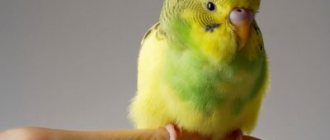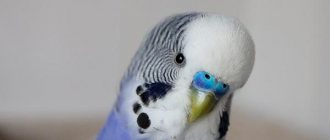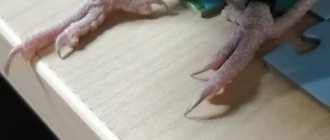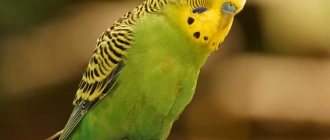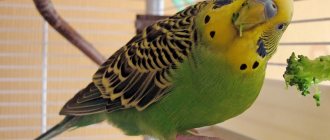According to statistics, almost half of all pet lovers give their preference to budgies. And this is not surprising! After all, this particular feathered pet is distinguished by its bright color, unpredictability, grace, incredible energy, and at the same time majesty and elegance. These pet flyer-talkers simply amaze their owners with positive emotions from the very first days of their stay in their new home.
Most of the owners of such pets strive to ensure that their parrot learns to talk as soon as possible - but this is not entirely difficult. It is very important to devote at least a quarter of an hour to class every day. The saying “Repetition is the mother of learning” would be very appropriate here.
But just think about how much joy you will get if you not only teach your pet to talk, but also to dance to some music. That is why today we decided to let you in on some of the secrets of how to teach a budgie to dance to music.
How to teach a budgie to dance?
Parrots are considered the most popular feathered pets in our country. Most pet lovers prefer budgies. Graceful, elegant, beautiful, energetic and majestic. These creatures know how to charge their owners with the most positive emotions. And what pleasure will you get if you teach a budgie to dance?
October 28, 2013
Author: Boyko Evgeniy
From the first sounds of pleasant chirping, you will fall in love with this lovely bird. Most owners immediately want to teach their parrot to speak - it’s not difficult. The main thing is to exercise regularly and daily (15 minutes a day will be enough). What delight and surge of emotions will a talking animal give you if you can also teach a budgerigar to dance? That is why the most pressing question remains: how to teach a budgie to dance and sing?
The main thing is to pay a lot of attention to your pet , love him, praise him, give him a piece of your soul. The success of training largely depends on the choice of music. It should be rhythmic, but not loud (deafening music can only scare the bird). There are times when you don’t need to teach your budgerigar to dance at all; he himself will start moving perfectly to the beat of the music. Remember which melody suits your pet best, and to which song the bird behaves more actively.
There is another way that can teach a budgie to dance.
What do budgies tweet about?
If you decide to learn how to figure out what your bird is all about or why it is chirping displeasedly, then for such a seemingly complex task you will only need patience and attention.
Sounds of budgies:
It is a widely known fact that parrots are excellent at copying sounds from their environment. And this will not necessarily be the speech of a person or birds outside the window; a parrot may well repeat the sounds of typing on a keyboard, ringing the doorbell and much more. Therefore, if the owner has a desire to teach his pet human speech, then the only obstacle can be the person’s laziness or lack of patience.
A parrot is capable of repeating not only words, but even phrases that sound with the same intonation with which a person pronounced them. Therefore, with the right approach and a reserve of limitless patience, you can start learning. After a while, your beautiful, bright pet will begin to repeat not only words, but also phrases and even entire sentences.
How to teach a parrot to move to music
If he refuses to move to the music, then help him. To do this, place it on your finger; it will be better if it sits safely on your palm. Now gently shake your hand to the beat of the playing melody, thereby signaling further actions. This activity is so exciting that before you know it, while playing, you will have mastered the first basics of the training process, how to teach a budgie to dance. Now the training will increase.
Now you can shake your head, watching the reaction of your feathered pet. In a moment he will do the same. Several of these productive activities will surprise you with the first results. The main thing is desire and patience. There is no need to demand impossible acrobatic tricks from him and pay more attention to him. Do everything gradually and thoughtfully. There is no need to rush and put pressure on a peculiar student. If you really want to teach your bird something, then believe me, you will succeed, sooner or later. But the results, as a rule, will not keep you waiting long.
A favorite treat, in the form of the first praise, will make the bird try even harder. Don’t forget to praise your pet with pleasant words and stroke him gently. Naturally, he does not understand the meaning of your words, but birds, like most other animals, perfectly sense the intonation of a voice - melodic, calm, measured and incredibly kind. Be positive . Think of classes as a kind of games, then your partner will behave accordingly. Don’t despair if the first results are not yet visible, everything will work out.
Home » Birds » Corella
Simple tricks: how to teach a cockatiel to talk?
The parrot is a cute and cheerful bird that can help not only brighten up loneliness, but also cheer up anyone. Birds that can speak are especially prized. Teaching a parrot to talk is not difficult, the main thing is desire and patience. So, let's find out how to teach a cockatiel to talk.
November 22, 2013
Author: Zvyashchenko Ulyana
Most people, not having the opportunity to often be in nature, try to bring it as close to themselves as possible by keeping various cats, dogs, and parrots at home: wavy birds, lovebirds, and cockatiels. The latter, in this case, are the optimal solution, because they can not only become pets, but also real friends, especially if you teach them to speak. How to teach a cockatiel to speak?!
First rule!
On the first day of acquiring a parrot, you should not try to teach the cockatiel to speak. First of all, you should provide the bird with peace. The cage should be in a place where there are no drafts, radiators or direct sunlight. It must be at the level of the person’s eyes, not higher and not lower.
For the first two weeks, the parrot does not need to be released from the cage. This will be the main rule for taming. You need to let the bird know that it is not in danger. In two weeks, the cockatiel will get used to its owner a little and will no longer be afraid of him. However, this does not mean that the bird will freely walk in its arms. No, that's still a long way off.
Making a parrot dance - perfect music for birds
You need to speak in a clear voice so that the bird understands the words well. If the cockatiel slowly opens and closes his eyes during training, it means he listens carefully and remembers. You need to repeat such easy lessons every day . The best time to study is morning or evening. At this time, the bird looks a little sleepy, but this has a successful effect on learning. At the same time, there should be no strangers or sounds in the room.
It should be remembered that parrots most often reproduce sounds that are often heard. Therefore, you should not be surprised if the bird reproduces a telephone call more than a previously learned word.
Melodies for developing speech skills
Music can be used not only to entertain a parrot, as it can speed up the process of learning human speech. The main rule is to practice regularly with birds.
To effectively use melody when training your pet, it is advisable to use simple tips:
Only if there is a positive attitude, the wavy quickly learns to speak, so you need to praise and encourage your pet for successes with goodies.
During training, you can find out what kind of music the bird likes . The wavy learns its favorite songs very quickly, so the correct choice of composition has a positive effect on learning results.
Source
If you don't have time
Most people do not have free time, and the desire to have a talking bird at home exceeds their capabilities. That is why you can use modern technologies: record some melody or words on a disk and leave it on . In this case, you will not only teach your cockatiel to speak, but also brighten up his loneliness.
One way or another, you need to remember that it is much easier to teach a young bird to speak . For training, it is best to take young parrots (no older than 9 months). And if such lessons do not produce positive results in the near future, do not despair, because close contact, trust and communication with the bird over a longer period of time can work wonders.
You've probably seen on TV how parrots and other birds dance to music. Teaching a parrot to dance is not at all difficult. The tips below will help you with this. You can find out how you can encourage a bird, how to teach it to move to the accompaniment of music. The additional exercises that your feathered pet learns will definitely benefit him.
Why does a parrot make unpleasant noises?
Runs around the cage and screams
This kind of active movement usually means that the bird is not getting enough flight. Energy arises that she needs to throw out somewhere. When keeping parrots, you should keep in mind that daily walks outside the cage are a necessary condition for keeping them.
Vigorous movements of birds also occur during the period of “family creation”. The male dances on a perch, cleans the feathers of the chosen one and feeds her. And the female shows increased activity, collecting suitable building material for the nest.
A short period of bird screaming should not cause concern. If she does this all day without stopping, it is necessary to inspect the conditions in which the bird is kept. Perhaps he is missing something, or something scares him. Parrots often scream when they experience stress, such as losing a mate.
Anxiety can also be caused by a change in diet. This especially happens soon after purchase. Find out from the breeder what food he is used to, and if you need to switch to a new one, switch gradually.
Important! After acquiring a bird, some time must pass before it fully adapts to its habitat and new owner. Typically this period lasts about two weeks.
Yells in the morning
Anyone who has had these birds at home knows that parrots emit perhaps the loudest, one might say, jubilant cries in the mornings. Ornithologists, and just people who have studied the behavior of birds well, will tell you with confidence that in this way they simply greet a new day, connecting to the general chorus of birds outside the window.
Most often, the morning trills and chirps of your pets do not indicate illness, but rather indicate health and good spirits. The biorhythms of domestic animals, like their wild relatives, coincide here: activity, including vocal activity, usually occurs at the beginning and the very end of daylight hours.
Screams at night
As a rule, the parrot is not active at night. If this happens, then it is possible that the bird is experiencing malaise and pain. You should not immediately start giving her any medications, even on the advice of friends. First, it is better to contact a specialist.
However, it happens that the owner, who is next to the cage, makes noise himself. Or perhaps a sudden light hit the bird’s house (for example, from headlights), or some other disturbing factor appeared - and the bird simply reacted to it with a voice.
Choose upbeat music
By nature, birds respond to all sounds, so it should not be surprising that they hear and react differently to different types of music. To teach a bird to dance, you need to choose cheerful, cheerful music. Medium to fast rhythmic music usually gets parrots moving. Don't be discouraged if your feathered friend doesn't respond to the music you've chosen. Just keep experimenting with different music. Sooner or later you will find exactly the melody that your parrot will like.
What compositions are chosen?
When choosing music for a wavy, rhythm and dynamics are taken into account. Birds are not experts, so they may like a completely unusual song. Even whistling evokes pleasant emotions in some individuals. Some birds prefer to listen to classical music, while others like dance tunes.
Statistics show that birds have a positive attitude towards music with words, so ordinary electronic tracks are sometimes ignored. If you turn on monotonous music at all, the bird may become depressed or begin to behave aggressively.
This behavior is due to the fact that the brain of parrots is more complex than that of other birds. They can perform complex cognitive tasks, so they can concentrate, perform dance moves, and are also distinguished by developed thinking.
Does your parrot like to listen to music?
YesNo Usually birds do not concentrate on only one musical style, therefore they are considered music lovers:
Therefore, it is recommended to choose music wisely so as not to spoil your pet’s mood.
Video – Dancing parrot
This is how you can teach a parrot to dance
Recently, scientists are increasingly making discoveries thanks to the Internet. Biologists from The Neurosciences Institute in La Jolla found a video about an unusual parrot on YouTube. We discovered, viewed and decided to conduct a study of the bird’s abilities.
This video spread all over the world last year and has now been viewed by almost 3.5 million people. Scientists could not stand aside and decided to find out whether the 11-year-old cockatoo Snowball is really capable of synchronizing his movements with the rhythm of music.
Biologists, of course, had to come up with a reason why they simply had to study Snowball. It turns out that the bird's ability to shake its legs and head may shed light on the treatment of neurodegenerative diseases using music in humans.
“The rhythm of the melody sometimes helps people with Parkinson's disease coordinate their movements,” recalled graduate student Aniruddh Patel.
True, he immediately clarified that no one yet knows why this is happening. One way or another, everything comes to the point that if scientists manage to understand the mechanism of the bird’s brain in this particular case, then it will be a stone’s throw to treating Parkinson’s disease with the help of music.
But let’s return to the star bird, which loves to dance, if not to say have fun, to the famous Backstreet Boys song “Everybody”. Everyone who watched the video notes that for the most part Snowball’s movements correspond to the rhythm of the composition.
At first, scientists decided that the cockatoo was being prompted by a person behind the scenes. However, as Snowball’s former owner said, the parrot was taught to dance only at first (children and adults showed the bird rhythmic movements).
To find out if the parrot could dance on its own, Patel and his team visited him in August 2007 at the Bird Lovers Only sanctuary.
Parrot forums
The bird was given here along with his favorite chair and a CD with a song.
Scientists played the composition, slightly changing the playback speed from time to time, and filmed the movements of the cockatoo on video. Watch the videos here, here and here.
However, not all so simple. Of course, the parrot did not always dance, and it fell into rhythm almost by accident, using different speeds of movements during the course of its performance. But scientists did some painstaking work and found that slowing down the music led to the appearance of slow movements that were completely absent during fast plays of the song.
Statistical calculations have proven that the cockatoo's movements are not random and it really rocks to the music. At least in the best way he can.
Now Patel notes that Snowball is probably not the only parrot ready to dance.
In the near future, scientists will have to find out whether the parrot’s “dancing” corresponds to its natural movements, for example, during the mating season, or whether it has developed some of its own steps, and even whether the cockatoo will dance with its partner.
In the meantime, as expected, the Bird Lovers Only organization is making a real trademark out of the cheerful cockatoo. They now sell DVDs of the bird dancing and even T-shirts with Snowball on their website. However, Bird Lovers Only swears that all funds will be used to support other residents of the shelter.
By the way, for those who think that Snowball has bad taste in music, a video has appeared on YouTube in which a cockatoo dances to the music of Queen and Ringo Starr.
Indeed, parrots are not such stupid creatures as popular rumor would like to make them out to be. It is known, for example, that macaws love their owners very much, are jealous and miss them, in general, they behave no worse than “man’s best friend” - a dog.
In addition, parrots call each other by name, protect their owners and learn some philosophical concepts themselves.
Read at the same time about how, thanks to the World Wide Web, biologists discovered a self-destructing palm tree in Madagascar.
Musical experiment
Information about dancing parrots interested zoologists. Scientists from the UK decided to test experimentally whether birds really dance. Three Grays were chosen for the study as the most intellectually developed. The birds played compositions from different genres: reggae, rock, country folk, classical. Observers found that Grays actively danced to rhythmic melodies, while Bach's works had a calming effect on the birds.
Zoologists installed a touch screen with two buttons in front of the birds. After touching one of them, an audio recording of energetic, catchy music was turned on. Another button played quiet, relaxing sounds. Jaco pressed the buttons a total of more than 1,400 times in a month. At the same time, no dependence on a specific melody was revealed.
Different preferences
Experience with the screen showed that parrots are partial to melodies. They distinguish intonations, dance, falling into the rhythm. However, it was not possible to find out what kind of music birds like more. The experiment confirmed the diversity of preferences in this area: some birds have fun listening to the soundtrack of dance songs, others – listening to the recording of an instrumental orchestra, and still others like hard rock. Such differences in individuals of the same species living together are explained by the individuality of their characters.
Music without words
Parrots cannot be called music connoisseurs, but they do not like electronic recordings called “techno” or “club”. Birds don't like computer generated sounds. After listening to such compositions, birds become uncontrollable and aggressive. They flap their wings, make noise, and express their displeasure in every possible way. In addition, such annoying works have a bad effect on learning.
Parrots not only dance, but also repeat words from songs and copy intonation. Talking birds expand their vocabulary by listening to audio recordings daily. If you love music, your pet has every chance of becoming a music lover.
Source
